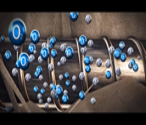CRACK DEVELOPMENT BETWEEN MASONRY AND R.C.C. MEMBERS AND ROOT CAUSES TO EXCLUDE THE PROBLEM
ABSTRACT
Crack development along the joint between masonry and R.C.C. is considered as a confusing problem in civil engineering. There are controversies and several trials are still carried out at site to avoid this complex problem. Most common practice is reinforcing the joint with wire mesh. This is from the concept to accommodate the differential thermal expansion and contraction of R.C.C. and masonry, as well as preventing shrinkage. Other concepts focus on flexibility of the joints, making groove, better curing of finished surface. The analytical study on this topic emphasis on the root cause to eliminate the problem.

A typical example is presented here
DESCRIPTION
R.C.C. frame with masonry fill, the combination is very common in building construction. This article does not focus on expansion joint and other areas of building which is subjected to weather condition or room atmosphere. This will focus only the cause of crack development between R.C.C. and masonry. This is a very common problem which ultimately turns into a controversial discussion after the plastering work is finished.
These cracks are developed between R.C.C. and masonry. Mostly along the three locations, at the bottom of R.C.C. beam and top of brick, similarly along the vertical joint between R.C.C. column and brick.
Brick laying is started from the top of R.C.C. beam and continued up to the bottom of a R.C.C. beam. Brick are laid by cement, sand mortar. Let us consider a fly ash brick work
which typically looks like 
Now, we will do a simple calculation. Brick manufacturing companies can make different sizes of fly ash bricks like

Let us consider a R.C.C. frame structure, depth of top R.C.C. beam is considered 500 mm. span is 5M. If 10-12 mm mortar joint is taken into consideration the actual number of bricks and arrangement of bricks depends on various conditions. practically this is difficult to maintain uniform joint thickness. So, there is always an adjustment is necessary at the edge. This adjustment is very common at the column edge and bottom of beam. Moreover, after 3-4 layers of brick laying, the green mortar joint at the starting layer is compressed due to top load of bricks. That also is one of the reasons of adjustment at the bottom of beam. Sometime the top layer is finished with superficial mortar filling or thick mortar filling which is out of consideration. If there is a little space to place the mortar between bottom of beam and last layer of brick, the laying is completed somehow by finishing from outside rather placing the mortar to fill the gap between bottom of beam and top layer of brick. Similarly horizontal brick layer ends at column faces. Due to the same reason an adjustment is required at the edge of columns.
The following sketches are presented for understanding the proper laying of bricks to eliminate the crack problems between R.C.C. & masonry.






In view of thermal expansion Fly ash brick absorbs heat only on its surface exposed to environment which has no impact on it expansion and contraction after installation Whereas expansion coefficient of clay brick is only 3.7 millionths per degree centigrade . Now comparing R.C.C. the amount of thermal expansion and contraction of concrete varies with factors such as type and amount of aggregate, richness of mixture, water-cement ratio, temperature range, concrete age, and degree of saturation of concrete. A typical value of thermal expansion and contraction of concrete is on the order of 10 millionths per degree Celsius, that is, very near the same as that for steel. If an unrestrained slab or wall 30 meters long has a temperature variation from summer to winter of 38 degrees Celsius, the total thermal movement might be about 1.5 to 1.8 centimetres. Movements occur at the exposed surface of the concrete, which cools off more quickly, before they occur in the interior of the section, leading frequently to additional warping or curling effects. Observations of buildings in service indicate the total movement is usually less than half of that which might be anticipated by combining the contraction due to temperature drop with the shrinkage. This is due to restraining effects of the reinforcing steel and restraining effects of columns, walls, and foundations. The following calculation can establish the above.

So, it is clear that there is a negligible expansion-contraction impact on masonry in a R.C.C. frame structure.
Coming back to the discussion on crack development, if the bricks are laid maintaining standard joint thickness at the edges of beam or columns, the cracks cannot appear.
But, practically it is quite difficult. Therefore proper technical guidelines must be there to eliminate the cracking problem along the joint between bottom of beam and last course of brick layer, similarly, along the vertical joint between the edge of column and masonry. This can be explained by following illustrations. A civil engineer Mr. Arun Maity has illustrated the technical concept from practical point of view which is relevant to establish the concept at project site.

Conclusion– Project supervisors and skilled masons have a great role in this job. In our traditional brick laying practice, normally masons have limitation in doing the work properly. A civil construction supervisor monitors on-going construction to ensure that the work is being done correctly and the project stays on schedule. So, quality of masonry is of high importance which depends on supervising engineers and skilled masons too. Their serious effort can help us to eliminate a common problem.





0 Comments